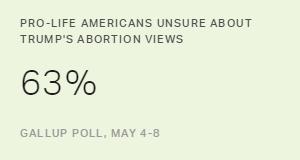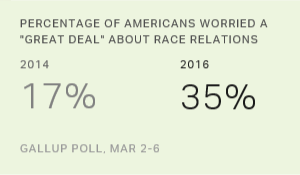One of the trickiest aspects of assessing American public opinion is measuring views on a new or complex issue that has not been thoroughly considered by the public. In these situations, there are no historical trends to provide context, and the public is more likely to respond in terms of cues given to them in questions than is the case for more well-established issues or policies.
This is clearly evident in the current measure of public opinion on the issue of laws or policies regulating who is and is not allowed to use traditional men's and women's restrooms. This issue has entered the news stream in relationship to a focus on transgender rights, particularly in regard to a controversial new law regulating restroom use in the state of North Carolina.
CNN published poll results on the topic based on interviewing conducted April 28-May 1, accompanied by the headline "6-in-10 Oppose Bills Like the North Carolina Transgender Bathroom Law." As is often the case, news outlets picked up the results with a typical headline, reading "The First Major Poll on 'Bathroom Bills' Is Good News for Transgender Advocates."
Here's the specific wording of the CNN question:
"Overall, would you say you favor or oppose laws that require transgender individuals to use facilities that correspond to their gender at birth rather than their gender identity? Do you [favor/oppose] that strongly or somewhat?"
The results, as reflected in the headlines, show that 57% "somewhat" or "strongly" oppose and 38% "strongly" or "somewhat" favor these laws.
Fast forward to a week or so later, when we at Gallup asked about the issue in a somewhat different format. Rather than asking an "up or down" question about a specific law, we gave the respondents two options, as follows:
"In terms of policies governing public restrooms, do you think these policies should -- [ROTATED: require transgender individuals to use the restroom that corresponds with their birth gender (or should these policies) allow transgender individuals to use the restroom that corresponds with their gender identity]?"
The results from this question wording were the opposite of the CNN responses. We found 50% opted for the first option that requires transgender individuals to use a restroom corresponding with their birth gender, while 40% chose the latter option, allowing them to use a bathroom corresponding with their gender identity.
More recently, a May 13-17 New York Times/CBS News poll asked about the issue in a format that was generally the same as that of Gallup:
"Do you think people who are transgender -- that is, someone who identifies themselves as the sex or gender different from the one they were born as -- [ROTATED] should be allowed to use the public bathrooms of the gender they identify with or should they have to use the public bathrooms of the gender they were born as?
The results were similar to the Gallup results, with 46% choosing the "born as" option and 41% choosing the "identify as" option.
In summary, the measures giving respondents a choice between two options found opposition to the idea of allowing transgender individuals to use the bathroom of their gender identity, while the one question asking about favoring/opposing a postulated law requiring facility use corresponding to birth gender found support.
There are several differences in these question formats and wording:
- The CNN question posited a law requiring facility use limited to birth gender, while the Gallup and New York Times/CBS questions gave respondents two options from which to choose. It's possible that it is easier for a respondent to say they favor a policy when both sides of the issues are spelled out in more detail.
- The CNN poll did not use the term "bathroom" or "restroom," but instead used the term "facility." A check with CNN indicates that there wasn't a reference to what "facility" meant in the question preamble or previous narrative in the poll context. This makes it possible that respondents were more likely to oppose the idea of the law because they didn't realize it would affect something as specific (or as personal) as bathroom use.
- The CNN question used the term "laws," while the Gallup question used "policies" and the New York Times/CBS question didn't define the nature of the "allowing" as used. It's possible respondents were more likely to oppose when the sterner term "law" was used in the CNN question.
The effects of these differences are all empirically testable using traditional split-sample, experimental design techniques. We at Gallup have not had the opportunity to do so on this measure but may do so in the future.
What we are left with is a reinforcement of the point I made at the beginning of this post. Caution is warranted in interpreting the results or implications of any one question asked in isolation, particularly when it is a) a new question without a history or trend context, and b) when it is asking about a policy or issue area about which the public has probably not spent a lot of time considering.
This is very similar to what happens in medical research. Any one study can be provocative or suggestive, but most medical practitioners look for replication, context and broad interpretation before using the results of one study to guide actual practice.
I think that at this point, I would be most likely to say that the American public has not formed firm opinions on the new issue of policies or laws surrounding transgender individuals' use of bathroom facilities and that the public is -- to a degree -- open to argument on either side. Plus, the available evidence does not consistently support the conclusion that Americans favor laws or policies allowing open access to bathrooms based on an individual's claimed gender identity.


